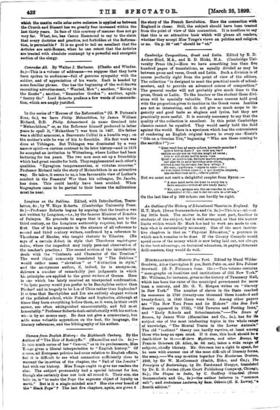MrscattAxsous.—Historic New York. Edited by Maud Wilder Goodwin, Alice Carrington
& yce, Ruth Patn,m, and Eva Palmer Brownell. (G. P. Putnam's Sons. 1294—This volume contains " monographs on localities and institutions of Old New York." Mr. Williams, for instance, gives us the history of Tammany Hall, which has been the ruler of the municipal government for more than a century, and Mr. G. V. Morgan writes on "Slavery in New York." The number of slaves in the State reached its maximum in 1790 (twenty-one thousand three hundred and twenty-four), in 1840 there were four. Among other papers are "The New York Press and its Makers" the New York Gazette appeared in 1725), "Old Taverns and Posting Inns," and " Early Schools and Schoolmasters."—The Dawn of Reason, by James Weir (Macmillan and Co., 5s.), has for its subject one of the most inteVesting topics in the whole range of knowledge, " The Mental Traits in the Lower Animals." The old "instinct" theory can hardly survive, at least among those who keep an open mind. If it does, this book should be a death-blow to it.—Modern Mysticism, and other Essays, by Francis Grierson (G. Allen, Se. 6cl net), takes a wide range of subjects, chiefly literary. Mr. Grierson has a right to speak, for he uses with success one of the most diffi..ult of literary forms, the essay.—We may mention together The Hunterian Oration, 1899, by Sir W. MaoCormack (Smith, Elder, and Co.); The Principles of Bacteriology, by Dr. Ferdinand Hueppe, translated by Dr. E. 0. Jordan (Open Court Publishing Company, Chicag,, 94.); The Plague in India, by C. Godfrey Gaustzel (Swan Sonnenschein and Co., 2s.)—the author believes in "common salt"; and Ambulance Lectures, by Saul. Osborn (H. E. Lewis), "a fourth edition."






































 Previous page
Previous page